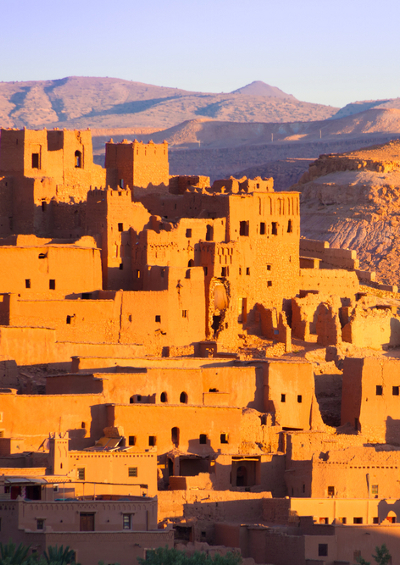Morocco’s Future in Farming Cooperatives
An updated system of local cooperation could help rural Morocco meet its true potential.
July 19, 2014

Many countries around the world face severe challenges when it comes to developing the economic potential of their rural regions. Morocco is an interesting case in point.
To make progress, the country relied on establishing agricultural cooperatives. Their goal was to build social cohesion and overcome problems such as depressed markets and stagnant production.
Challenge – and potential
Rural farming families working in Morocco’s High Atlas mountain region have seen global prices for the walnut and almond crops they grow double over the past ten years. And yet, the revenues they received have basically remained the same.
The systems of agricultural production and maintenance they use — although incorporating vital traditional skills and knowledge — are not primarily directed toward the optimization of quantity. Rather, it provides them with subsistence and the most basic continuity of life.
Part of the reason is that families, clans and entire communities may live side by side –- and are yet ever so distant from each other. Local events that took place decades and even generations ago have divisive consequences that remain very much alive.
However, with population growth, rising prices and globalization, antiquated production structures ensure that rural areas lag ever more behind urban ones. As a result, systemic rural poverty deepens and the economic divide compared to people living in cities grows starker.
Organic growth
At the same time, cooperatives represent a vital and integral part of harnessing the latent Moroccan rural potential. What stands in the way of success is that the marginalized countryside communities have never had the means to purchase and plant agricultural crops that require the application of harmful pesticides.
What may seem like a disadvantage to some is a clear-cut benefit to others. The result is that their surrounding environment — air, soil, the entire ecosystem — remains chemical-free.
This is a highly desirable factor on the part of consumers, expressed particularly in the developed world. This fact, when presented in the right manner, practically ensures the securing of organic certification.
Thus, the nuts, figs, cherries, dates, olives, pomegranates, lemons, carob, prickly pears and several dozen medicinal plants, growing in different parts of Morocco, could obtain organic certification.
This, along with the introduction of other value-added processes, would enable farming families to realize the vast opportunity that is rightfully theirs.
Changing the ecosystem
Of course, this is much easier said than done – and seemingly impossible without the formation of well-organized, economically efficient local cooperatives.
For example, the creation of plant or tree nurseries is essential to generating the billion or more trees and plants that Morocco needs as part of overcoming subsistence agriculture.
Moroccan farming families are transitioning from growing barley and corn — which are grown on 70% of land yet account for only 10-15% of agricultural revenue — to cash crops, most commonly fruit trees.
The growing demand for fruit trees increases their price, keeping many farmers on subsistence farming. Community-managed tree nurseries produce trees from seeds at a fraction of the cost of buying young trees from existing, private nurseries. They enable the building of new skills so that farmers can replenish their orchards with trees in the future.
Nurseries, however, require land that can be openly accessed by all its potential beneficiaries, in an arrangement that benefits all households.
Moreover, training in organic practices and project management needs to be delivered on a broad basis. Training needs an experiential basis in order to make the necessary vital difference in practices. Machinery for processing and packaging is prohibitively expensive for the few — less so for the many.
International buyers seek quantities of product beyond what a single village can provide. Many villages, once properly focused on working together, can provide the desired quantity.
All these examples underscore the necessity of the coming together of families, clans, communities, municipalities and provinces. When that happens, then farm cooperatives help successful, sustainable agricultural development emerge.
Three factors for success
How can this be achieved in practical terms? First, present-day agricultural cooperatives in Morocco and around the world require an outside catalyst to help jump start the all-important dialogue process needed. This enables people to express their interests and needs as well as to identify ways that they can be made mutually compatible.
Third-party facilitators play a role that cannot be underestimated in its importance. Without them, communities are much less likely to create fruitful plans of action embodying their self-determined goals.
Facilitators can be teachers, government and civil workers, friends and neighbors — indeed any community member. They need to undergo public and private training specializing in facilitation for cooperative building.
Second, partnership building with government, civil and private groups is a vital necessity in the formation process and efficient functioning of cooperatives. The support that they can provide in all stages ”from farm to fork” is critical not just for initial success, but even more so for long-term sustainability.
The people’s property
Finally, cooperatives must remain unequivocally and indelibly the property of the people. The basis for unlocking latent potential is essentially rooted in personal empowerment and elevated levels of decision-making skills.
The members of cooperatives can invest a portion of their new revenues in other human development projects that have the potential to change their quality of life. Revenues from agriculture can also help communities with clean drinking water, school building, women and youth initiatives and any other priorities they identify.
Cooperatives are indeed unique. They are controlled by and afford benefit to the very people who have established them.
They open themselves up to multi-sector partnerships at all societal tiers and reach out to a global public who express increasing satisfaction, including at the ethical level, with the product that grows in their fields and on their terraces.
In conclusion, Morocco’s rural communities – and those throughout the world – have much to gain from modernizing the structures of their cooperatives. If and when that happens, their livelihoods may improve considerably.
Takeaways
Cooperative-farming systems could help build rural wealth in Morocco – and the rest of the developing world.
A simple system of local cooperation could help rural Morocco meet its true potential.
To create rural prosperity, Morocco must overcome depressed markets and social conflict.
Rural Morocco’s organic soil-bred crops could appeal to buyers worldwide.
A gap of wealth grows between Morocco’s farms and cities. Rural collectives could help close that gap.
